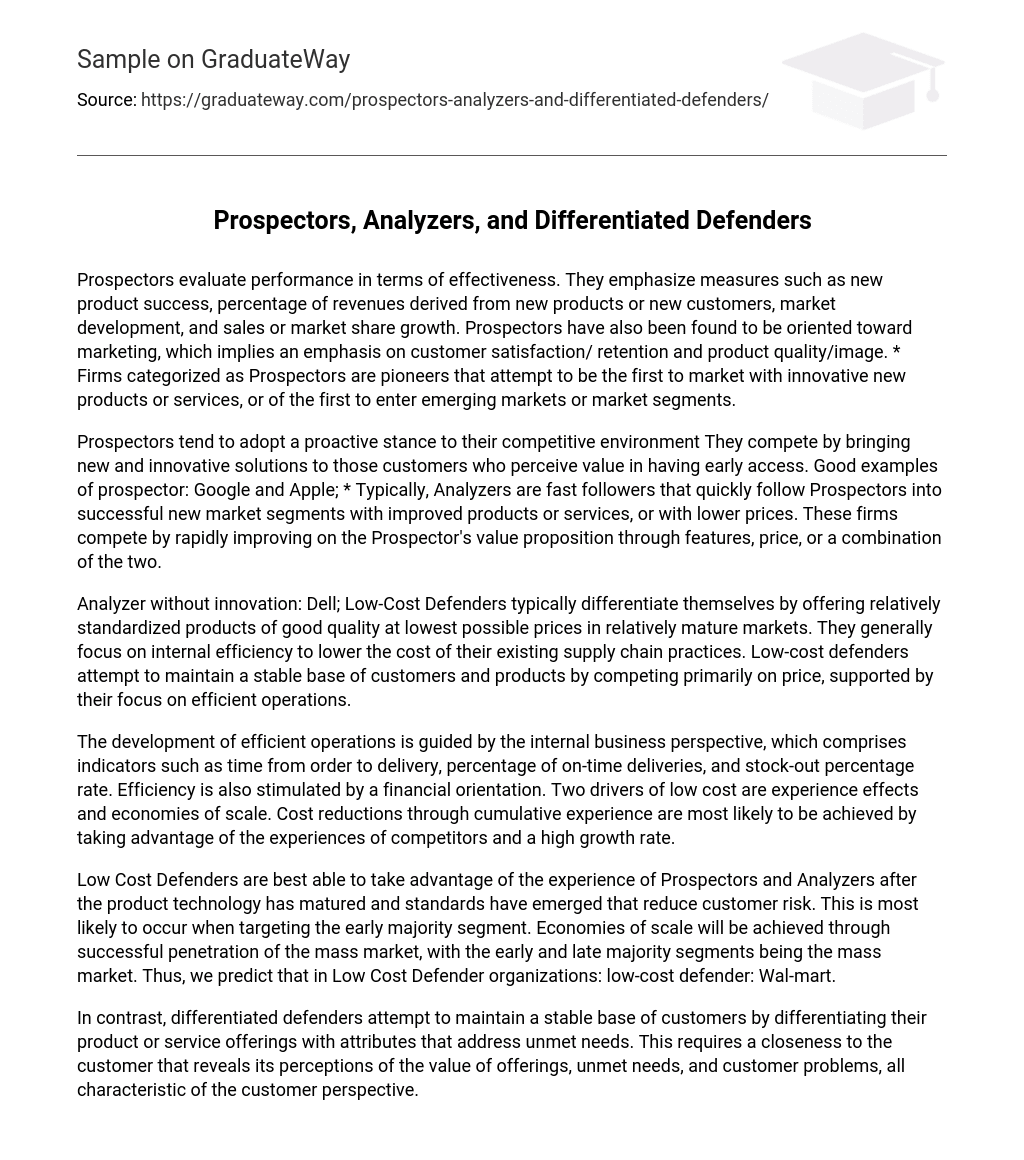Prospectors evaluate performance in terms of effectiveness. They emphasize measures such as new product success, percentage of revenues derived from new products or new customers, market development, and sales or market share growth. Prospectors have also been found to be oriented toward marketing, which implies an emphasis on customer satisfaction/ retention and product quality/image. * Firms categorized as Prospectors are pioneers that attempt to be the first to market with innovative new products or services, or of the first to enter emerging markets or market segments.
Prospectors tend to adopt a proactive stance to their competitive environment They compete by bringing new and innovative solutions to those customers who perceive value in having early access. Good examples of prospector: Google and Apple; * Typically, Analyzers are fast followers that quickly follow Prospectors into successful new market segments with improved products or services, or with lower prices. These firms compete by rapidly improving on the Prospector’s value proposition through features, price, or a combination of the two.
Analyzer without innovation: Dell; Low-Cost Defenders typically differentiate themselves by offering relatively standardized products of good quality at lowest possible prices in relatively mature markets. They generally focus on internal efficiency to lower the cost of their existing supply chain practices. Low-cost defenders attempt to maintain a stable base of customers and products by competing primarily on price, supported by their focus on efficient operations.
The development of efficient operations is guided by the internal business perspective, which comprises indicators such as time from order to delivery, percentage of on-time deliveries, and stock-out percentage rate. Efficiency is also stimulated by a financial orientation. Two drivers of low cost are experience effects and economies of scale. Cost reductions through cumulative experience are most likely to be achieved by taking advantage of the experiences of competitors and a high growth rate.
Low Cost Defenders are best able to take advantage of the experience of Prospectors and Analyzers after the product technology has matured and standards have emerged that reduce customer risk. This is most likely to occur when targeting the early majority segment. Economies of scale will be achieved through successful penetration of the mass market, with the early and late majority segments being the mass market. Thus, we predict that in Low Cost Defender organizations: low-cost defender: Wal-mart.
In contrast, differentiated defenders attempt to maintain a stable base of customers by differentiating their product or service offerings with attributes that address unmet needs. This requires a closeness to the customer that reveals its perceptions of the value of offerings, unmet needs, and customer problems, all characteristic of the customer perspective. This attention to superior products or customer service also indicates the opportunity for premium pricing and an emphasis on profitability. Differentiated Defenders compete in well-established markets by offering superior quality products or services at premium prices.
They focus on implementing their current activities by taking advantage of elements that they do particularly well. The cost of their practices is typically higher than the industry average. The key to success for Differentiated Defenders is to provide premium service and/or the highest quality products to market segments that value and are willing to pay for them. The Differentiated Defender’s focus is on maintaining its position in established (early and late majority) markets (Walker & Ruekert, 1987).
The Differentiated Defender’s value proposition is based on a nuanced understanding of its customers. Differentiated Defenders are skilled at segmenting the early and late majority markets to identify those segments that value superior quality and service (Slater & Olson, 2001). Consequently, the most successful Differentiated Defenders will emphasize customer-oriented behaviors. While this does not mean that they ignore competitors or do not engage in product or service innovation, these are not primary activities.
Toyota, on the other hand, in recent years has become the Differentiated Defender of the auto industry as we know it here in the United States. For years Ford, GM, and Chrysler have been the stalwarts of the American auto industry but recently Toyota has grown to be the largest auto manufacturer in the United Sates by differentiating themselves from the big three with their early emphasis on smaller cars with higher gas mileage. Early in the current decade this trend was not forecasted by the big three US automakers, Toyota differentiated themselves and they now lead the market.





